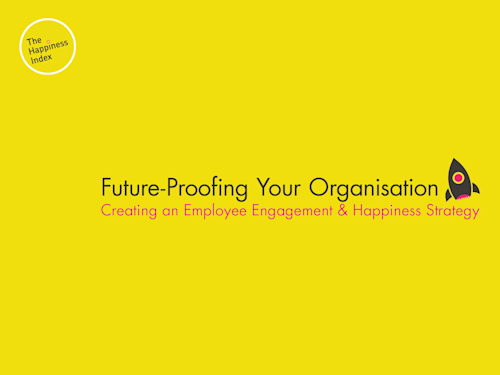
Creating an Employee Engagement AND Happiness Strategy
What’s more important than being healthy and happy at work? Here at The Happiness Index, we don't think there is anything more important! If you’re instantly thinking of profits, customer service and market share - then you should read on to find out why workplace wellbeing is so important to your bottom line.
70% of employees report that they’ve missed work this past year due to mental health issues. Only 28% of employees report feeling “very engaged” in their work.
- Headspace
We spend a shockingly high percentage of our lives at work. If your people are unhappy, unhealthy or have any other issues surrounding wellbeing – then you should address this! Failure to establish a culture that encourages employee wellbeing can lead to employees having wandering eyes and your business being less attractive to the next generation of workers - who often value happiness over pay and benefits. Promoting workplace wellbeing can help prevent stress and create a culture where employees and organisations will thrive, and be seen as more attractive to job seekers.
You might have put time and resources towards building a strong vision and brand, improving your product/services and investing in new tech. But that overlooks the most important element of your business… your people! What have you done to improve their wellbeing?
According to the National Health Service in the UK, the principal reason for work stress is a lack of support and understanding from managers/leadership. When people are stressed, exhausted and feel that they aren’t listened to in the workplace it’s detrimental to their health, happiness and performance.
Shockingly, it was reported in 2022 that 3 out of 4 employees are forcing themselves into work when they are unwell! Whilst some may think of this as an act of heroism, it is actually more likely to harm your organisation than do good.
Last year the Government reported 1.8 million working people suffering from a work-related illness, of which:
914,000 workers suffering from work-related stress, depression or anxiety
477,000 workers suffering from a work-related musculoskeletal disorder
123,000 workers suffering from COVID-19 which they believe may have been from exposure to coronavirus at work
Every successful company is dependent on healthy and productive employees – but more importantly than that – a caring and empathetic employer can put employee workplace wellbeing and happiness at the top of the agenda!
The COVID-19 pandemic has pushed employee wellbeing to the top of boardroom agendas over recent years and there is a lot of evidence that supports the correlation between employee wellbeing and performance. If you look after your employees they will return the favour tenfold. Valued and supported staff are far more likely to deliver better outcomes for your organisation. They will happily go above and beyond – even more so if they are aligned with your vision and goals. If you want to retain staff and increase the talent pool when recruiting – it’s essential to prioritise the physical and mental health of your staff. Make it a core part of your business plan… today!
Missed work days – Even something as seemingly insignificant as an incorrect desk setup can have a big impact. Government data shows that 7.3 million working days in the UK were lost due to work-related musculoskeletal disorders in 2021/22.
Presenteeism – Wellsteps found that smokers were 28% more likely to have high presenteeism than non-smokers. Employees with an unhealthy diet were 66% more likely to have high presenteeism than those who ate a more nutritious diet. Employees who didn’t exercise very much were 50% more likely to have high presenteeism than employees who were regular exercisers.
Lost revenue – Government data shows that in 2020 ill-health cost the UK economy £11.2 billion!
Missed work days – An estimated 17 million working days were lost due to work-related stress, depression or anxiety in 2021/22 according to the Health and Safety Executive (HSE) annual statistics.
Lost revenue – Mental health problems cost the UK economy at least £117.9 billion annually according to a report published by Mental Health Foundation and the London School of Economics and Political Science (LSE).
Staff turnover – According to Deloitte 61% of people planning to leave their jobs in 2022 cited poor mental health as the reason for leaving.
According to Headspace’s 2022 Health Report employees and CEOs are both missing work due to mental health issues, but CEOs are missing more... The graph below indicates how many days of work have been missed over a 12-month period due to stress, anxiety or any other emotional or mental health challenge.

We can see from the graph that 30% of employees reported no missed days due to mental health issues while only 17% of CEOs can say the same.
The Happiness Index has taken the principles of neuroscience to form our own unique methodology to help us understand the triggers that can harm the physical and mental wellbeing of both our employees and our customers’ employees.
Our work on workplace wellbeing uses our neuroscience methodology. We predominantly focus on the Instinctive brain system of the employee for health and the Rational brain when it comes to organisational support. In layman’s terms, neuroscience helps us to understand people’s instinctive responses to their mental and physical health and the rational enablement of organisational support. More about the brain systems here.
Want to create a thriving culture where no one suffers from poor mental/physical wellbeing? These are the three main areas that must be addressed:
Here we are focused on the issues relating to our psychological safety, which sits in our Instinctive brain system. For example, the positivity of relationships, healthy work-life balance and levels of stress.
Next, we look at our physical health where we - once again - focus on our Instinctive brain system. This time it’s the need to stay fit and healthy. This is predominantly focused on energy, nutrition, health and physical activity.
When we understand the mental and physical wellbeing of our people the real work happens! This is where organisations need to step in to ensure they are doing all they can to improve/sustain wellbeing and they are fostering the right company culture.
Organisations that focus on these three areas position themselves as empathetic leaders who truly care. This creates a thriving and healthy culture where people will be motivated to come to work and help businesses fulfil their goals.
As a business you may want to consider what annual wellbeing initiatives might help educate and benefit your poeple.
Many companies provide easy access to plenty of drinking water, a gym membership scheme, or other physical health interventions… but it’s important not to forget about mental wellbeing. Headspace reported that “71% say their company increased focus on mental health because of the pandemic, but only 25% say they’ve kept that focus up.” A worrying statistic! Consider a workplace mental health survey to find out what's really going on with your people and how best you can help them.
Burnout is a very real and very prevalent problem in today’s workplace, especially where employees are particularly engaged – 48% of UK workers have experienced burnout rising to 66% of US workers. There are lots of tell-tale signs that your employees may be suffering from burnout – The Journal Of Organisational Behaviour lists fatigue, irritability and health problems. Training your team to spot signs of burnout and create a safe environment where employees feel they have the resources and support to recover is also key. Read our simple guide to spot the signs and understand the differences.
Burnout, poor management and leadership concerns creep up as COVID-19-related stress slightly recedes.
- Headspace
Encourage your team to focus on their mental and physical health, and ensure everyone knows you are a line of support for them. Ensure everyone understands that they’re able to take time off when they need it – this doesn’t just mean the flu or family bereavements – it can also mean they simply can’t face it! It might seem extreme but creating a supportive workplace where suicide prevention is prioritised is so important in this day and age.
Financial wellbeing guru, and close friend of The Happiness Index Gethin Nadin, told us that on average people take 3 days off per year due to financial stress. On top of this, Barclays estimated in their Financial Wellbeing report that poor financial wellbeing was costing employers four per cent of their payroll – which included issues relating to mental health. By paying everyone fairly and offering programmes within the organisation to support this, you can help minimise this. You can also help by providing other resources to build financial literacy - We’ve pulled together this useful guide to help employers support their employees with the cost of living crisis as a start.
Two-thirds of employees who are struggling financially report at least one sign of poor mental health that could affect their ability to function at work. These include loss of sleep, poor concentration, and reduced motivation.
- Mental Health at Work
Create new, agile ways to work that support the employee. Let them choose what flexible working means! Not only will your team feel more supported and valued but they’re also more likely to open up to you in the future about any wellbeing issues. This is half the battle!
Remember, there isn’t a ‘one size fits all’ when it comes to wellbeing. You might think you’re supporting your team’s physical and mental health by providing Yoga classes, but if they’d rather be going for a walk or meditating, you’re not going to be making as much of an impact as you may have wanted. Don’t guess on people’s behalf. Ask them and let them help you to help create a better culture that fosters better wellbeing for everyone!
For more tips on improving wellbeing in your workplace, check out the following resources:
Half of organisations (51%) take a strategic approach to employee wellbeing. These organisations are far more likely to report a number of positive achievements from their activity, at both the individual and organisational level.
- CIPD
Do you have the insight on how your people have been impacted, to ensure you aren’t facing a ticking wellbeing time bomb? Our Employee Voice survey data highlights that the prolonged nature of the pandemic has depleted resilience levels and people are struggling to replenish them.
We want to combat this and create a working world where good culture, health and wellbeing are commonplace. So we created a wellbeing Survey! Our Wellbeing pre-built survey is based on 3 themes: Mental health, physical health and organisational support.
Understand and combat any anxieties or stresses your people may have.
Identify and prevent wellbeing issues and position yourself as an empathetic leader who truly cares.
Create a thriving, happy and healthy culture where people will be motivated to come to work and help your business thrive and fulfil its goals.
Implement meaningful action plans and benefit schemes to prevent & combat wellbeing issues to build a happy and healthy workplace for the future.
If you want to take the first step towards creating a workplace of the future that puts employee health, happiness and wellbeing at the top of the agenda, then get in touch.

Linked to Happiness in our neuroscience methodology... learn more
The Happiness Index helps organisations measure the key employee engagement AND happiness drivers to power their people strategy.
Our unique platform offers the products, insights and tools to shine a light on your cultural health and empower management to drive thriving cultures.
Our neuroscience-based pre-built surveys measure the full employee experience - from onboarding to exit to empower and enable organisations to understand their people and create data-led action plans.
